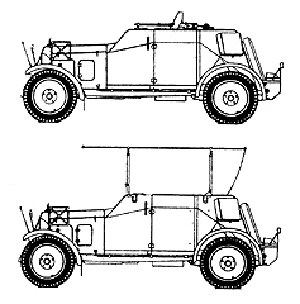Light Armored Scout Vehicles
|
The Army ended up with two Light Armored vehicles by 1932. These were two-axel (four wheeled) vehicles, their frame being made by Alder Works in Frankfurt, while the body was created by Deutsche Edelstahl AG in Hannover. They were designated as Kfz. 13 and Kfz. 14. Manufacturing began in 1932 and ran until 1934 with a total of 147 being produced. These two early models saw service in both Calvary and reconnaissance units of the Wehrmacht. A few are known to have survived through the opening stages of the war and into 1941. Being very opened-topped, they were nicknamed "Badewanne" - Bathtubs.
 |
• |
Kfz. 13 : One MG13 and a crew of two |
 |
• |
Kfz. 14 : A radio and a crew of three. |
With a top speed of 45 km/h, these two early models contained the fundamentals of what would be used to manufacture better light armored, wheel-driven vehicles. Several versions of German light armored scout vehicles existed during WW 2.
Below is a listing of these vehicles. A few I have linked to pages that contain more details on the variations.
 |
Types
|
 |
• |
Sd.Kfz. 223 - Light Armored Scout Vehicle |
 |
• |
Sd.Kfz. 260 - Small Armored Radio Vehicle |
 |
• |
Sd.Kfz. 261 - Small Armored Radio Vehicle |
 |
• |
Sd.Kfz. 247 A - Light Armored Command Vehicle |
 |
• |
Sd.Kfz. 247 B - Light Armored Command Vehicle |
 |
• |
Sd.Kfz. 250/9 - "Caesar" In 1943, a halftrack would start to replaced the light armored cars. |
 |
• |
Sd.Kfz. 123 - "Lynx" A full tracked light armored scout vehicle was produced using the chassis of the Panzer IIL. |
Click the Toten to return.
|

